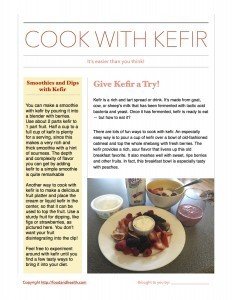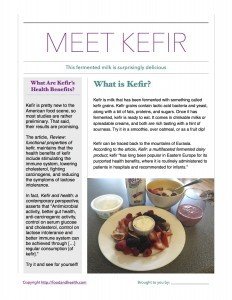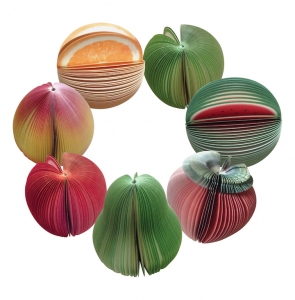Reader Request: Kefir
Thank you so much for all the wonderful requests you've been sending! I love delving into new research and ideas. In fact, I had so much fun looking into one of the latest requests that I decided to share my research with you!It all started with this email...
Dear Judy,
Hope you’re having a wonderful weekend!
Wondering how much you’ve worked with probiotics, and in particular, if you’ve tried Kefir? I recently tried it, and like it very much. If you haven’t tried it, it’s a little like buttermilk and thin yogurt. I tried the plain version, and found it a bit tart, so I added a little Stevia and vanilla. It’s great in smoothies, and think it might be good for dips and dressings. I’m not sure if it’s heat stable, but if so, could find all kinds of possible applications (puddings, desserts, any place you’d use milk). Think it would probably work well in your tofu pudding recipe. Not sure how it freezes, but if it freezes well, may make good ice cream type desserts.
All thoughts welcome!
Best regards, Sharol Cripe, RDN, LDN
Kefir? I'd never tried it before. What an intriguing idea! I set off to the store and am so glad I did. Kefir is awesome. I found a liquid one that can be used just like milk. It's thick and creamy and tastes like creme fraiche. And speaking of creme fraiche, I also found a thicker kind of kefir that can be used as a substitute for creme fraiche. I also noted that you can use Greek yogurt the same way and it has active cultures, too.So what exactly is kefir?The article, Review: functional properties of kefir defines kefir as a "unique cultured dairy product due to combined lactic acid and alcoholic fermentation of lactose in milk. Kefir is produced by microbial activity of 'kefir grains' which have a relatively stable and specific balance of lactic acid bacteria and yeast." Kefir grains hold the lactic acid bacteria and yeasts in a matrix of lipids, proteins, and sugars. The drink can be made with sheep, goat, or cow milk, though cow's milk kefir is by far the most common.In terms of its history, kefir can be traced back to the mountains of Eurasia. According to the article, Kefir: a multifaceted fermented dairy product, kefir "has long been popular in Eastern Europe for its purported health benefits, where it is routinely administered to patients in hospitals and recommended for infants and the infirm." Now that it has spread to the U.S., researchers are delving into the possible health benefits of kefir. In fact, "Due to the claimed health benefits of kefir which include reduction of lactose intolerance symptoms, stimulation of the immune system, lowering cholesterol, and antimutagenic and anti-carcinogenic properties, kefir has become an important functional dairy food and consequently, research on kefir has increased in the past decade" (source). Another study, Kefir and health: a contemporary perspective, asserts that "Antimicrobial activity, better gut health, anti-carcinogenic activity, control on serum glucose and cholesterol, control on lactose intolerance and better immune system can be achieved through [...] regular consumption [of kefir]."Let's zoom in on kefir's relationship with lactose. This milk drink appears to be well-processed even by people who are lactose intolerant. The study, Kefir improves lactose digestion and tolerance in adults with lactose maldigestion, revealed that "Because kefir improved lactose digestion and tolerance in this study, its use may be another potential strategy for overcoming lactose intolerance." Who knew?Now let's talk about consuming kefir. Members can see what I discovered when I started working with kefir in my kitchen in the post Cooking with Kefir. There are lots of great new photos and a brand-new handout to see there too.
I set off to the store and am so glad I did. Kefir is awesome. I found a liquid one that can be used just like milk. It's thick and creamy and tastes like creme fraiche. And speaking of creme fraiche, I also found a thicker kind of kefir that can be used as a substitute for creme fraiche. I also noted that you can use Greek yogurt the same way and it has active cultures, too.So what exactly is kefir?The article, Review: functional properties of kefir defines kefir as a "unique cultured dairy product due to combined lactic acid and alcoholic fermentation of lactose in milk. Kefir is produced by microbial activity of 'kefir grains' which have a relatively stable and specific balance of lactic acid bacteria and yeast." Kefir grains hold the lactic acid bacteria and yeasts in a matrix of lipids, proteins, and sugars. The drink can be made with sheep, goat, or cow milk, though cow's milk kefir is by far the most common.In terms of its history, kefir can be traced back to the mountains of Eurasia. According to the article, Kefir: a multifaceted fermented dairy product, kefir "has long been popular in Eastern Europe for its purported health benefits, where it is routinely administered to patients in hospitals and recommended for infants and the infirm." Now that it has spread to the U.S., researchers are delving into the possible health benefits of kefir. In fact, "Due to the claimed health benefits of kefir which include reduction of lactose intolerance symptoms, stimulation of the immune system, lowering cholesterol, and antimutagenic and anti-carcinogenic properties, kefir has become an important functional dairy food and consequently, research on kefir has increased in the past decade" (source). Another study, Kefir and health: a contemporary perspective, asserts that "Antimicrobial activity, better gut health, anti-carcinogenic activity, control on serum glucose and cholesterol, control on lactose intolerance and better immune system can be achieved through [...] regular consumption [of kefir]."Let's zoom in on kefir's relationship with lactose. This milk drink appears to be well-processed even by people who are lactose intolerant. The study, Kefir improves lactose digestion and tolerance in adults with lactose maldigestion, revealed that "Because kefir improved lactose digestion and tolerance in this study, its use may be another potential strategy for overcoming lactose intolerance." Who knew?Now let's talk about consuming kefir. Members can see what I discovered when I started working with kefir in my kitchen in the post Cooking with Kefir. There are lots of great new photos and a brand-new handout to see there too. Speaking of handouts, I've whipped up a quick kefir fact sheet, which you can download today! What will you do with your free copy?
Speaking of handouts, I've whipped up a quick kefir fact sheet, which you can download today! What will you do with your free copy? This post is brought to you by the Nutrition Education Store. We're here to help you look your very best, right now, and we've got the resources to prove it!
This post is brought to you by the Nutrition Education Store. We're here to help you look your very best, right now, and we've got the resources to prove it!


